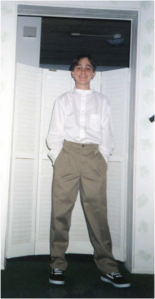By Sean McGrath March 20th, 2014 10:00 AM
I want you to think back for a moment to when you were thirteen years old. I mean really think back. Put yourself in the shoes of adolescent you. What was it like to be physically on the verge of adulthood but mentally still a child? With the hormones flowing through your body at an alarming rate, were you in control of your emotions and feelings, or did you allow them to control you? Were you dressed in all the latest fashions, or were you like the author, pictured below, who was a rock star only in his own mind?
It’s no secret that the teenage years are among the most tumultuous in a person’s life. Books like Surviving Ophelia and Raising Cain detail the crises that, respectively, adolescent girls and boys navigate during the ages of 11–19. The question is, why?
During these years, the human brain starts to develop from the ground up. The first segments of the brain to develop – the Brainstem and the Midbrain – are responsible for regulating the bodily functions necessary to survival: blood pressure, body temperature, and so forth. This leaves the Limbic and Cortex areas – those that regulate judgment, logic, reason, and rational thinking – as the last ones to mature. This has a huge impact on adolescent behavior, leaving teenagers more likely to behave with reckless abandon and ignore the consequences of their own actions.
It’s why so many people will inevitably respond with a “good luck” or a “you poor dear” when told that I choose to teach this challenging age group. So why do I choose to relive the worst years of my life 181 days out of the year? Precisely because of these aforementioned qualities.
The erratic nature of teenage years means that, without proper guidance and support, erratic behaviors can acquire permanence in a person’s brain. In fact, according to Linda Burgess Chamblain, PhD, in her pamphlet, The Amazing Adolescent Brain: What Every Educator, Youth Serving Professional, and Healthcare Provider Needs to Know: “Brain connections that are stimulated and used repeatedly grow stronger while unused connections wither away.” In essence, teenagers who are taught to think critically during the times when they are least likely to actually think critically, will be empowered to make positive life choices.
At my school, we begin every day with a Developmental Designs Circle of Power and Respect. This advisory program, created by Dr. Terrence Ross, consists of four parts: greeting, sharing, play, and reflection that meet the specific needs of adolescent children: autonomy, competence, relationships, and fun. Incorporating this understanding of middle-level children into daily lessons and classroom management means that I spend a lot less time yelling than I did during my first year as a teacher. Now, I understand my students better. A girl who is misbehaving in class by calling out is trying to assert her autonomy. A boy who would rather socialize than learn about The War of 1812 is expressing his desire to build interpersonal relationships. It doesn’t make that behavior any less frustrating in the moment, but it does allow me to tailor my reaction so that the behavior is corrected rather than punished. This corrective action, what we call “Take a Break”, builds a relationship with students while allowing them to reflect on their disruptive behavior.
For example, I had a student one day, Jeremiah*, who decided that he didn’t want to use his pencil anymore and flung it halfway across the room. While raising my voice at him, calling home, and giving him a zero would have all been warranted reactions, they wouldn’t have reached the root of the issue. Instead, I calmly asked Jeremiah to “Take a Break” in another classroom. J got up from his seat, grumbling along the way, took a reflection paper, and walked to the directed classroom. He came back 5 minutes later with his reflection sheet filled out. He was quiet for the rest of class. After the bell rang, I called him over to my desk and spoke with him for a minute.
“Hey man, lemme ask you something. What’s going on with you?” I said.
Silence.
“Okay, you don’t have to tell me if it’s personal, but your behavior in class today was inexcusable. You know we don’t throw pencils here. What’s going on?” I continued to pry.
After a brief pause, Jeremiah answered.
“Sorry, Mr. McGrath. There’s just this girl, and, well I don’t want to talk about it, but I shouldn’t have thrown that pencil.”
“I understand, bud. If you want to talk, you know you can come to me.”
“Thanks, Mr. McGrath, see you later. Oh, wait! What was the homework tonight?”
So, when people ask me why I teach middle school, it’s not just because I enjoy subjecting myself to erratic behaviors and outlandish statements – although, believe me, that’s absolutely part of it. I understand the needs these students have, and if I can, in some way, help them fulfill those needs and encourage them and guide them to become more thoughtful people, adolescence may just be a little more bearable.

